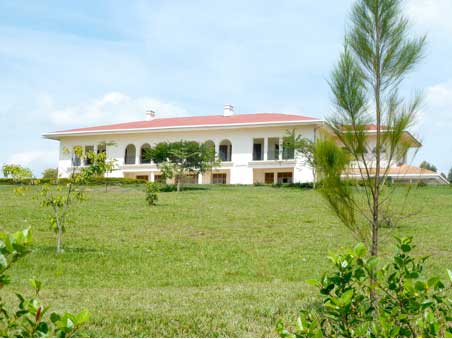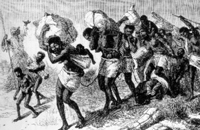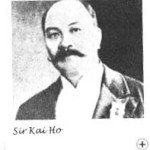The National Art Gallery, A Shining Gem On Rwesero Hill
Not many people probably know that The National Art Gallery (The NAG) in Nyanza is since 2006 a contemporary arts museum in Rwanda. It is even the only one in the great lakes district. The classical building hosting this museum has been constructed at the end of the fifties of the past century and is beautifully located in the scenic hills, just outside Nyanza. It was built for Rwanda’s last king Matara III Rudahigwa, who died in 1959, just before he would move into his modern palace.. Since Mutara’s death, the palace has hosted several judicial institutes, like the High Court and the Supreme Court. The late archeologist and visionair prof. dr. Celestin Kanimba, former DG of INMR, regarded contemporary art as one of the healing means to recover from the1994 genocide. The NAG is part of the Institute of National Museums of Rwanda, which includes 5 various national museums.
Architecture and location
The building, designed by Belgian architect Robert Quintet, has been constructed at the end of the 1950’s. It is beautifully located on top of Rwesero hill. The building and location itself can be experienced as an excellent typical Rwandese attraction, as a masterly mixture of landscape, colonial architecture and royal history.
It turned out to be a lucky shot to change the destiny of the palace into a museum.
In the first place because of the architecture and its surroundings. But even more important is its location in the city of Nyanza, were in former ‘royal’ days Rwandan culture was flourishing. The King’s Palace Museum is near and both museums are located far away from noisy cities like Kigali and Huye. Read more
Gold The True Motor Of West African History: An Overview Of The Importance Of Gold In West Africa And Its Relations With The Wider World
While the prime sources of gold remained more or less where they had always been, hidden from the outside world, along the headwaters of the Rivers Senegal and Niger (Wright 2007: 21).
Towards a Longer Time Frame for African History
Slavery and African slaves have dominated historical perspectives of Africa and its relations with the wider world. Yet, it is gold which has been the most important and enduring element that has shaped and determined West Africa and its interactions with the wider world. For at least 1,500 years gold and not slaves has been the commodity determining not only the region’s economy and history, but also West Africa’s links with the wider world.
Beginning in the late 1700s, understandable humanitarian concerns and philanthropic motives ensured that the focal point within public discussion and history, when dealing with West Africa, came to be centred on the issue of slavery. Focussing on slavery to the detriment of gold and other commodities to some extent ensured that the export of slaves from West Africa came to be halted in the course of the nineteenth century. The persistence of slavery within Africa, as well as the continued smuggling of slaves out of Africa, in many instances served to legitimate the intervention in, and subsequent occupation of, West Africa by Europe’s imperial powers. Ironically, those opposed to colonial rule made grateful use of the historical trope of slavery that existed within European discourse to hasten the end of colonial occupation in West Africa. Thus the discourse that had in many instances been used to legitimate the establishment of colonial rule, was also used to oppose colonial rule. But, and this is the important issue, in both instances it was the trope of ‘slavery’ that determined the manner in which lay and professional observers looked at West Africa’s past. In both instances it was a dehumanising and debilitating view of history that effectively robbed, and continues to rob, West African historical actors of any agency beyond being mere pawns in the West’s insatiable thirst and desire for slaves. The persistence of this negative history continues to rob West Africa of its rightful place in global history.
The focus on slavery has overshadowed and driven from both public and scholarly perception the realisation that West Africa’s history is far more than slavery alone; it is indeed a sad irony of history that the incessant focus on the dark past of slavery has managed to eclipse the bright history of gold in West Africa. A refocus of West African history, away from the past three hundred years to the longer perspective of nearly two thousand years, brings into focus a far more constructive and less passive history of West Africa and its inhabitants. Far from being merely the subject pawns of the deeply exploitative and dehumanising trade and economic systems initiated outside of Africa, a refocus on the role of West African gold in its relations with the wider world, brings to the fore a far more energetic and virile history in which West Africa’s relations with the rest of the world are based on a far greater degree of equality and shared interest.
This essay has been written with the express purpose of drawing to the fore the long history of gold in West Africa so that a new beginning can be made to refocus views of Africa and its people away from a debilitating and ultimately nihilistic focus on slavery. A focus on the long-term history West African gold will bring to the fore an interesting history in which Africans are not merely acted upon but ultimately determined the course of global history and humanity as a whole. Read more
POEM: The Vrije Universiteit And South Africa, From 1880 To The Present And Towards The Future: Images, Practice And Policies
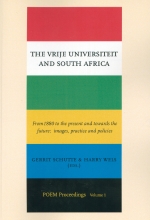 The Vrije Universiteit (Amsterdam) and South Africa share a long history together, dating back to as early as 1880. At times this history has been a turbulent one. The year 1994 marked the beginning of a new period in the relationship between the VU and South Africa. Currently, nearly all VU-faculties are actively cooperating with South African colleagues. But what type of academic knowledge and cooperation is the ‘new’ South Africa actually waiting for?
The Vrije Universiteit (Amsterdam) and South Africa share a long history together, dating back to as early as 1880. At times this history has been a turbulent one. The year 1994 marked the beginning of a new period in the relationship between the VU and South Africa. Currently, nearly all VU-faculties are actively cooperating with South African colleagues. But what type of academic knowledge and cooperation is the ‘new’ South Africa actually waiting for?
Gerrit Schutte, supported by the Faculty of Arts, together with Savusa (South Africa – Vrije Universiteit – Strategic Alliances) organised a mini-conference in October 2004 (called a Publication Oriented Expert Meeting or ‘POEM’ in Savusa jargon). The purpose of this POEM was to look at the future of the relationship between the VU and South Africa, and to investigate whether further continuation or even expansion of the relationship would be in the interest of both VU and South African academics.
SAVUSA POEM Proceedings, Volume 1 – Rozenberg Publishers, 2005
Now online:
Albert Grundlingh – Some Trends In South African Academic History: Changing Contexts And Challenges. (incl. the Introduction of the Proceedings by Harry Wels and Gerrit Schutte)
Tom Lodge – Political Studies In South Africa. A Personal Perspective.
Ena Jansen – A ‘new’ literature.
Flip Smit – ‘New’ Scientific Practice In South Africa With Special Reference To Land Reform.
Gerrit J. Schutte – The Vrije Universiteit and South Africa: 125 years of sentiments and good faith
Edutainment Radio Programmes
 The ways in which journalists frame HIV stories can strongly contribute towards news consumers’ perceptions of the epidemic. This paper discusses the news values of HIV radio programmes in Ethiopia, Kenya and South Africa. It argues that the culturally appropriate ‘humanisation’ of HIV stories and the proper use of conflict as adding news value are paramount to the impact of stories.
The ways in which journalists frame HIV stories can strongly contribute towards news consumers’ perceptions of the epidemic. This paper discusses the news values of HIV radio programmes in Ethiopia, Kenya and South Africa. It argues that the culturally appropriate ‘humanisation’ of HIV stories and the proper use of conflict as adding news value are paramount to the impact of stories.
The skillful application of news values can make almost any HIV-related story newsworthy and therefore part of mainstream news. Moreover, it is maintained that HIV advocacy environments contribute to the newsworthiness of HIV stories in the media.
The AIDS advocacy milieus of South Africa and Kenya are compared and related to the type of HIV stories that are published and broadcast in the respective countries. Journalism training methods are critically discussed in the context of the above. It is argued, that, in developing countries, where journalists often lack basic journalism skills, it is not sufficient to provide reporters with HIV-related information; HIV information sharing should be combined with general journalism training and mentoring.
Introduction
In December 2007, an excited Bashir Osman – a Somaligna-speaking journalist from Dire Dawa in the east of Ethiopia – broadcast a live call-in show on breastfeeding and HIV to his Somali audience on Dire 106.1 FM. According to the most recent Ethiopian government figures, Dire Dawa has the second highest HIV prevalence rate in the country, and almost doubles the national average. Each year there are almost 1, 000 HIV positive pregnancies with at least 230 children born with the virus. Yet this was the first HIV programme that Bashir had ever produced. AIDS was so stigmatised in the region that Dire 106.1 FM hardly ever discussed it on air. And Osman had no problem following this route. A week before the broadcast, the journalist – like most of his listeners – refused to be in the same room as people with HIV because he “didn’t want to risk breathing the same air” (Osman cited in De Masi, 2008) as them. He would never consider sharing a plate, or hosting an HIV positive person in his home, and thought it a deep insult to be tested for the virus.
But then Osman accessed what turned out to be a precious piece of culturally relevant information: he learned that babies of HIV positive women can get infected with the virus through their mothers’ breast milk (personal communication, December 6, 2007). All mothers with babies in his community breastfed their infants x including his very own wife. His own five-month old baby could be at risk, he perceived with shock, because neither he nor his wife knew their HIV status. The realisation changed Osman’s entire view on AIDS, and HIV was suddenly a virus that had the potential to directly impact his own life and those of everyone else he knew, in ways he had previously vehemently denied (personal communication, December 6, 2007). In short, this piece of information made AIDS newsworthy to Osman, his community and his editors. It became something that was crucial and worthwhile to talk about.
HIV and the News Media
Several communication experts, AIDS activists and journalists (Collins, 2005; Kinsella, 1989; Malan & Gold, 2006; Scalway, 2003; Shilts, 1987) have argued that the news media have the potential to be an immensely powerful tool in the response to HIV. According to the Joint United Nations Programme on HIV/AIDS Executive Director (UNAIDS), dr. Peter Piot, “journalists can save more lives than doctors in terms of HIV prevention because preventing HIV is about communication and changing norms” (Piot, 2006).
Proving statements like this, however, is very complex; studies have not been able to conclusively show that stories in the news media have resulted in change in HIV-related behaviour on a large scale. Research has, however, strongly suggested that news stories are capable of setting the framework in which citizens discuss public events. McCombs and Shaw (1972) demonstrated that there was a strong relation between the topics that the news media highlighted during an American election campaign and the topics that news consumers identified as important. Another US study illustrated the power of broadcast news to set the policy agenda when it proved that evening news bulletins had the effect of defining the policy areas by which the president should be judged (Iyengar et al., 1984).
McCombs and Ghanem (2001) have argued that “the level degree of emphasis placed on issues in the mass media influences the priority accorded these issues by the public” (cited in Reese, Gandy & Grant, 2001, p. 67). Dearing and Rogers (1996) stated that this proposition had been supported by more than 200 studies. But, I would argue that the regular publishing or airing of stories on a certain subject does necessarily lead to the public taking note of that subject. If such stories do not directly relate to the lives of readers or broadcast audiences, or are not presented in captivating ways with strong news values, they are unlikely to influence news consumers’ opinions – whether negatively or positively. In the case of a highly stigmatised and sensitive subject such as HIV/AIDS, even more so. Read more
Occupied
 She smiles happily. She dances against the backdrop of a red banner that says Anticapitalista in Coca Cola letters.
She smiles happily. She dances against the backdrop of a red banner that says Anticapitalista in Coca Cola letters.
About an hour later I walk home.
I used to work for an antiquarian bookseller and one of his infamous statements comes to mind. “You can also know too much”, he would mumble grumpily whenever anybody was too eagerly displaying knowledge.
Not that a lot has changed. Don’t give me a pen and paper in order to make a list of what’s wrong with this world. I know I’m not supposed to, but secretly I still smile sometimes when the news shows images of shattered windows and smoking cars.
But I know more now. The revolution often aims wrong. The cars and the stores, they are innocent.
That’s the least of it.
It’s even sadder. I know now that summer comes after spring if you’re lucky. More often, nature throws a curve ball and goes straight to fall. Skips summer, just like that.
The beauty of revolution is in that one minute, that tiny spark, the core that starts it, wrote Canetti. It contains the sole ingredient we get to work with. Hope. No matter how naive. Without hope, nothing ever changes.
The sound of a bluesy piano drifts from an open window. “Of course”, I think to myself and smile.
If I was 18 years old, I would be standing right there, up front. At present time, I don’t want to crush the flower as it’s just starting to open her eyes.
Once Upon A Time – And Everything Changed
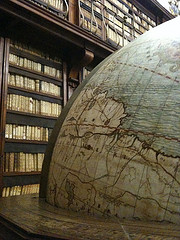 A day at the end of June, 8:36 a.m. – A high-speed train, G7381 with the name “Harmony”, takes me from Shanghai to Hangzhou.
A day at the end of June, 8:36 a.m. – A high-speed train, G7381 with the name “Harmony”, takes me from Shanghai to Hangzhou.
Apparently it was Marco Polo who said 下来有苏杭 上 有天堂 and indeed, it seems to be heaven on earth. I am traveling there on the ground, at the earthly speed of nearly 350 km.
Outside the built-up areas, the fields, the streets and the huge green-house areas – passing by like images from a dream, appearing and disappearing like the clouds one may see looking out of the window of an aircraft … 350, 300 …… 250, 200, 180, 140, 90, 80, 55, 30, 20, 10, 9, 7, 4 … the train stops.
It has been a while since I lived in a town in Germany – mind, not a village, not a city: a town. It has approximately 25,000 inhabitants and occasionally we would go to a city nearby: a place with probably 100,000 inhabitants. Well, we thought of it as a city. At least it had an opera house and a theatre and I had been privileged enough to occasionally be able to go there – after finding the required transportation and money. It’s among my favorite childhood memories, one of the things I thoroughly enjoyed during my childhood. Perhaps I enjoyed it so much because it made a little dent in an environment that seemed, and actually was, smooth. Any attempt to escape only lead to slippery ground that, although it required permanent movement, did not allow progress.
A little later this tiny, seamless world had burst. For me, in the same way as for the many others who turned to the streets at the end of the 1960s – against the aggressors in Vietnam, against German media-giant Springer who had been one of the gofers of the aggressors in the far-east; against the Gaullist system in France. But we also turned to the streets in favour of matters – of Bloch’s notion of the Principle of Hope and Marcuse’s realist utopia: You should sleep for nine hours without dreams. Then you will have the whole day for dreams.
Read more: Once Upon A Time-And-Everything-Changed
